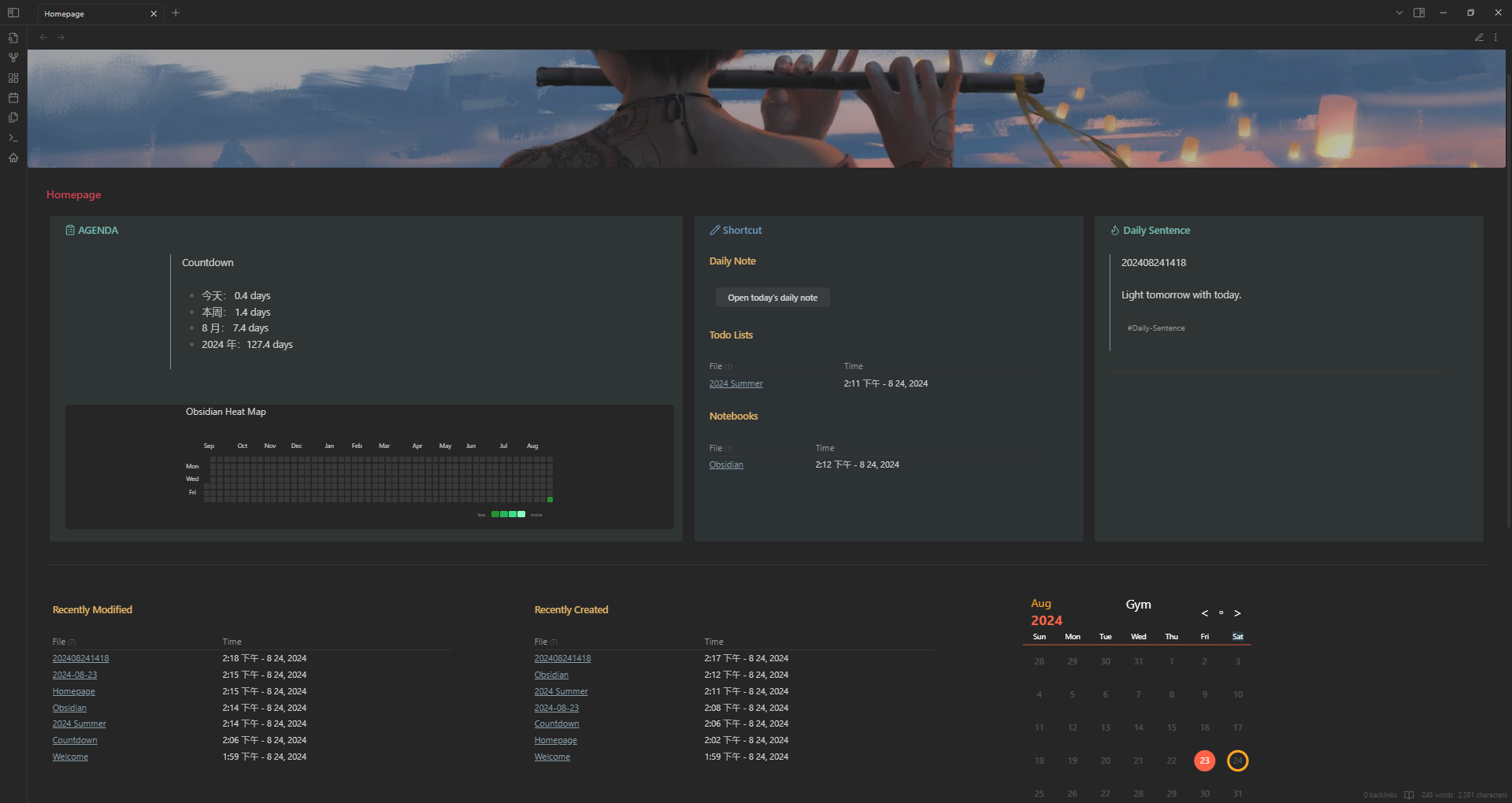How to DIY Obsidian homepage
How to DIY your Obsidian homepage from scratch?
Obsidian Homepage plugin enables to open a specified note as a homepage upon launching Obsidian. As for me, a good homepage works as a dashboard and facilitate my workflow. Here is my version of Obsidian homepage, you can also download the template vault from my GitHub repository and play around.
Screenshots

Key Features
- Countdown
- Display and update the countdown automatically
- Obsidian Heat Map
- Similar to GitHub heat map, it displays how many files you create everyday (you can adjust it according to your need)
- Daily Sentence
- Randomly select one note (in a particular way) and display its content (my implementation is one sentence per note with some tags)
- Daily Note Button
- Open or create Today’s Daily Note via a button
- Automatically roll over unchecked checkboxes from your last Daily Note
- Habit Tracker
- Track your habits and display in the calender
Prerequisites
- Plugins:
- Banners
- Buttons
- Contribution Graph
- Dataview
- Homepage
- Iconize
- Minimal Theme Settings
- Rollover Daily Todos
- Style Settings
- Tracker
- CSS Snippets
- You can download the CSS snippets from my github repository and drag them into your
vault/.obsidian/snippets(if the folder does not exist you can create one yourself) .
- You can download the CSS snippets from my github repository and drag them into your
Start From Scratch
1. Create the banner image
---
banner: "![[homepage.jpg]]"
banner_x:
banner_y: "0.1"
banner_lock: "true"
cssclasses:
- wide-page
---Note: if your
Propertiesis still there after you switch into reading mode, check the settingProperties in documentinEditorand set it toHidden.
2. Create the middle columns
> [!multi-column]1. First column: Countdown and Obsidian Heat Map
This column contains the display of the file called Countdown and Obsidian heat map, which shows how many files you create in Obsidian in the past year.
>> [!summary|wide-5 min-0] AGENDA
>>```dataviewjs
>>dv.paragraph("![[Countdown]]");
>>```
>>```contributionGraph
>>title: Obsidian Heat Map
>>graphType: default
>>dateRangeValue: 360
>>dateRangeType: LATEST_DAYS
>>startOfWeek: 0
>>showCellRuleIndicators: true
>>titleStyle:
>> textAlign: left
>> fontSize: 15px
>> fontWeight: normal
>>dataSource:
>> type: PAGE
>> value: ""
>> dateField: {}
>>fillTheScreen: false
>>enableMainContainerShadow: false
>>cellStyleRules:
>> - id: 1724115409974
>> min: 1
>> max: "15"
>> color: "#019131ff"
>> text: ""
>> - id: 1724115427584
>> min: "15"
>> max: "30"
>> color: "#18b55dff"
>> text: ""
>> - id: 1724115437365
>> min: "30"
>> max: "50"
>> color: "#3be084ff"
>> text: ""
>> - id: 1724115462228
>> min: "50"
>> max: "1000"
>> color: "#8afebfff"
>> text: ""
>>```Note: you need to create a file called
Countdownand write your countdowns in that file.
2. Second column: Daily note button and file shortcuts
This column contains the button that executes the command Daily note: Open taday's daily note and the lists of files with certain properties.
>> [!note|wide-3 min-0] Shortcut
>> ### Daily Note
>> ```button
>> name Open today's daily note
>> type command
>> action Daily notes: Open today's daily note
>> ```
>> ### Todo Lists
>> ```dataview
>> TABLE WITHOUT ID link(file.link, title) as "File", file.ctime AS "Time"
>> WHERE alias = "todo list"
>> ```
>> ### Notebooks
>> ```dataview
>> TABLE WITHOUT ID link(file.link, title) as "File", file.ctime AS "Time"
>> WHERE alias = "notebook"
>> ```Note: your language should be English otherwise the button won’t work due to the error
Command not found.
3. Third column: Daily Sentence
This column contains the daily sentence, which displays the content of a random file from a list of files with the same tag.
>> [!tip|wide-3 min-0] Daily Sentence
>> ```dataviewjs
>> let files = dv.pages("#Daily-Sentence");
>> let length = files.length;
>> dv.paragraph("![["+files[Math.floor(Math.random() * length)].file.name+"]]");
>> ```Note: this requires you to store the daily sentences manully in your vault with a tag
#Daily-Sentence.
3. Create the buttom columns: Recent files and Habit Tracker
This three columns contain the display of recent files and Habit Tracker.
---
>[!multi-column]
>> [!blank-container]
>> ### Recently Modified
>> ```dataview
>> TABLE WITHOUT ID link(file.link, title) AS "File", file.mtime AS "Time"
>> FROM -"Images"
>> SORT file.mtime DESC
>> LIMIT 10
>> ```
>
>> [!blank-container]
>> ### Recently Created
>> ```dataview
>> TABLE WITHOUT ID link(file.link, title) as "File", file.ctime AS "Time"
>> FROM -"Images"
>> SORT file.ctime DESC
>> LIMIT 10
>> ```
>
>> [!blank-container]
>> ``` tracker
>> searchType: task.done
>> searchTarget: Gym ⏫ 🔁 every day
>> folder: Daily Notes
>> datasetName: Gym
>> month:
>> color: tomato
>> headerMonthColor: orange
>> todayRingColor: orange
>> selectedRingColor: steelblue
>> showSelectedValue: true
>> ```Note: the Habit Tracker actually collects your data from your notes. You need to have your target task, i.e.
searchTarget, in your daily note, i.e. files in thefolder, and click it manually which gives thesearchType: task.done.
Dataview Troubleshooting:
- In dataview,
""works for folders while#works for tags. For YAML you should useWHERE.- In dataviewjs, by contrast, you need to use
""for tags and'""'for folers. (Personally I think it is confusing for beginners, especailly those who have no idea about writing Javascript.)![[]]will givedataviewjsthe file content, and thendv.paragraphwill display in the particular position.
Now it is done!
